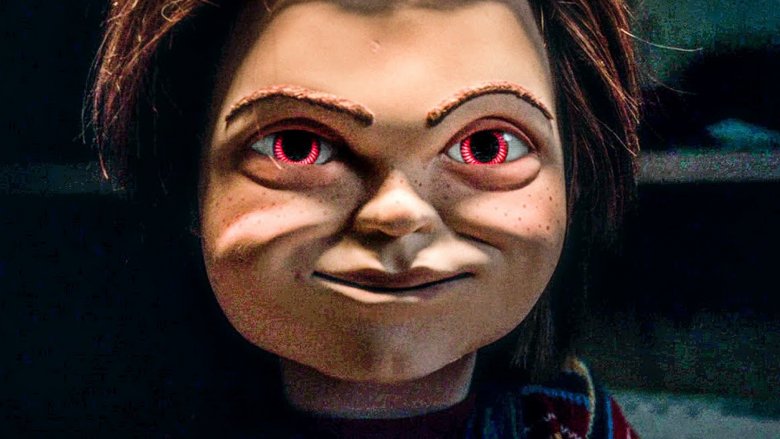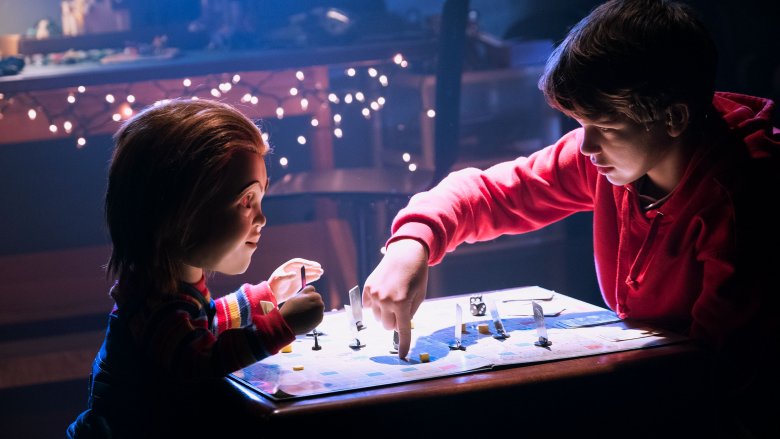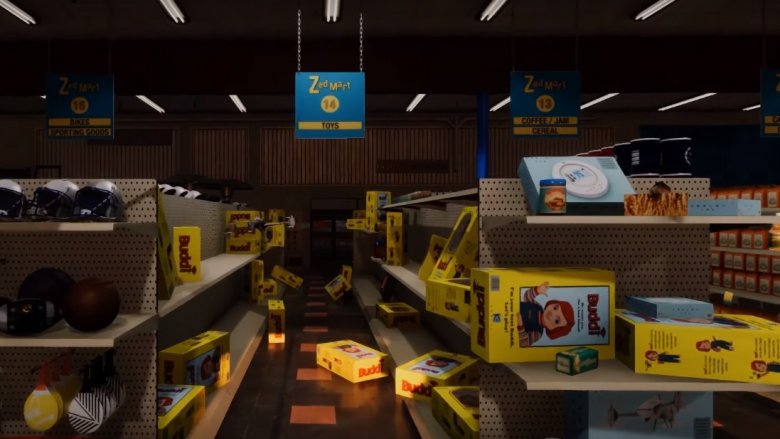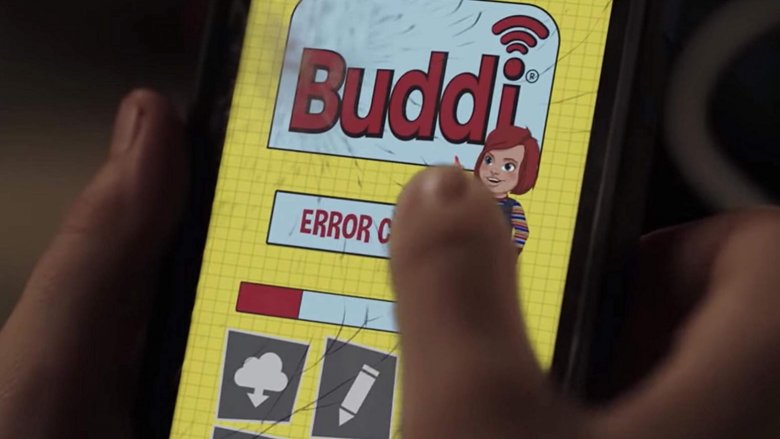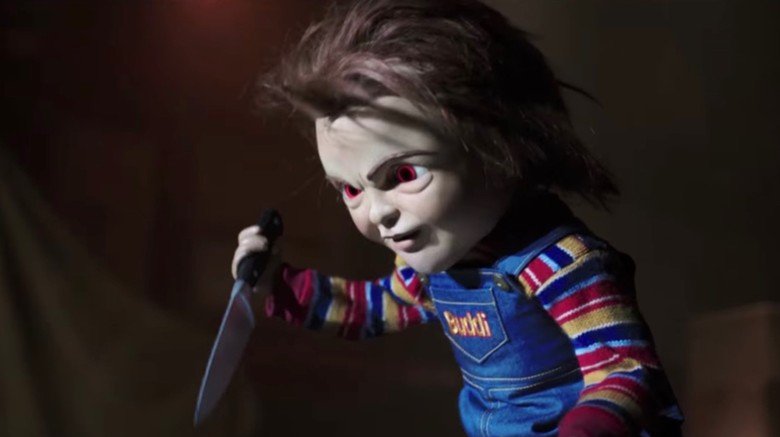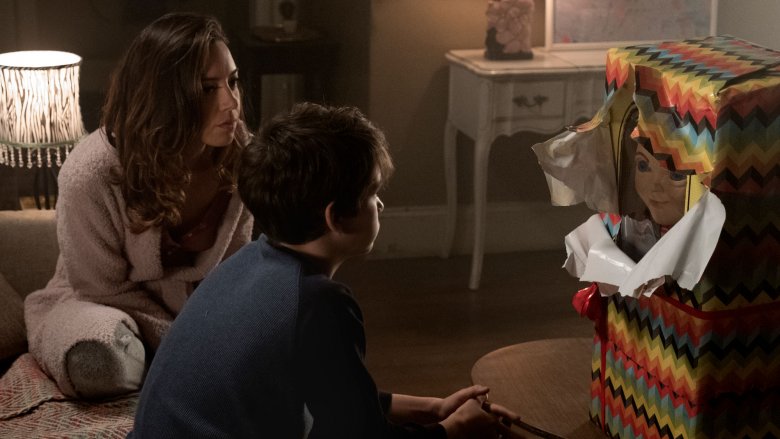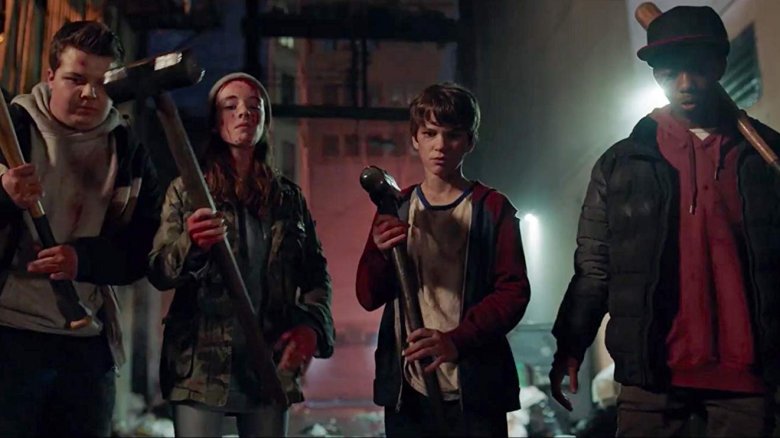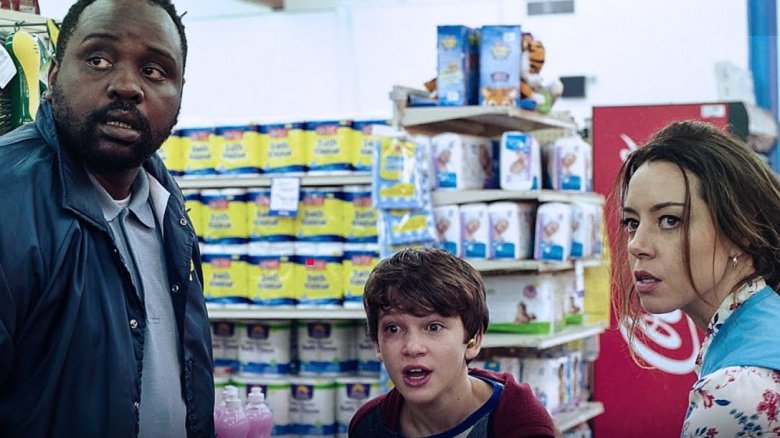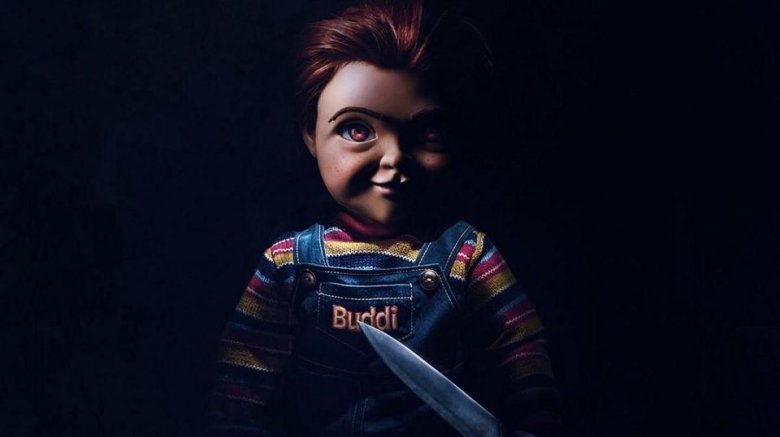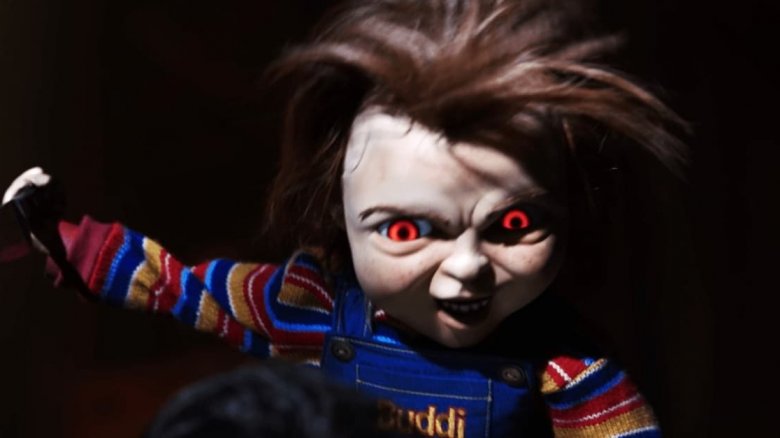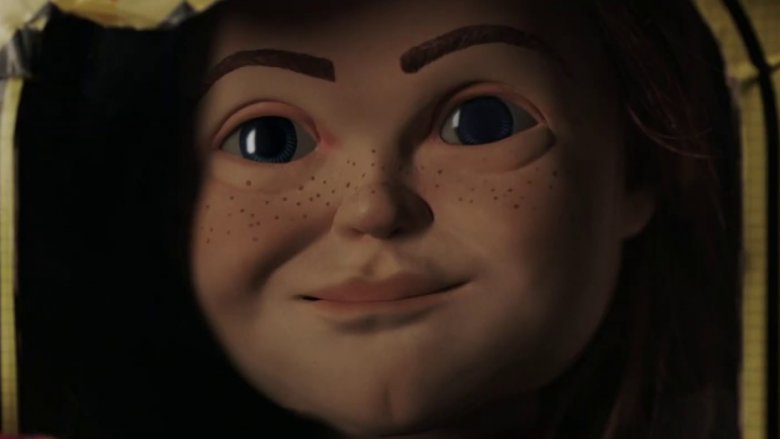The Ending Of Child's Play Explained
He's back, he's short, and he's going to be your friend 'til the end if it kills you. Chucky returns in the remake/reboot Child's Play with the psychotic doll voiced this time by the guy famous for Jedi Knights and killer clowns — Mark Hamill.
Directed by Lars Klevberg and written by Tyler Burton Smith, the new Child's Play is every bit the slasher flick you would want it to be, but in many ways manages to be very different from the original. In 1988's Child's Play, the killer "Good Guys" doll was possessed by the soul of serial killer Charles Lee Ray (Brad Dourif), but this time around there's no sorcery involved in the doll's insanity. Chucky is a "Buddi" doll produced by the Kaslan corporation. Possessing a degree of artificial intelligence and wifi capability to interact with other Kaslan products, the Chucky of the new Child's Play goes bad because a vengeful factory worker in Vietnam removes all of the doll's behavioral safeguards after his abusive boss fires him.
Using the much more familiar avenue of technology to effect Chucky coming to life in all the wrong ways allows for Child's Play to do quite a bit more within the genre than you'd expect, while remaining bloody and darkly hilarious. It also goes a long way to explaining why the end of Child's Play is hardly the end of Chucky.
Robot apocalypse
One unofficial narrative rule of cinema is that if any kind of artificial intelligence is involved, that A.I. is eventually going to lose its cool and try to kill everyone. Child's Play is no exception and at least some of the characters are aware of it. When Andy (Gabriel Bateman) reveals to his friends what Chucky has been doing, Falyn (Beatrice Kitsos) warns that this is exactly how "every robot apocalypse movie starts."
Child's Play takes a lot of inspiration from those flicks. If you're familiar with '80s and early '90s science fiction movies in which A.I. was a factor, it's impossible not to sense that influence in Child's Play. When Andy explains to Chucky that he absolutely can't kill anyone or anything — after the doll's first attempt to kill the family cat — it sounds a lot like the young John Connor (Edward Furlong) setting down the same rule for his Terminator bodyguard (Arnold Schwarzenegger) in 1991's Terminator 2: Judgment Day. When Doreen's (Carlease Burke) fatal trip in the driverless Kaslan Car starts going sideways, it's tough not to remember Schwarzenegger's ride in the automated Johnny Cab in 1990's Total Recall. And when Chucky sends a remote control toy police car to lead Andy to where his mother Karen (Aubrey Plaza) is held hostage, we hear Peter Weller's voice come out of the car with the line from 1987's RoboCop: "Dead or alive, you're coming with me!"
Corporate evil
You could argue that the chief villain of Child's Play isn't Chucky, but Kaslan Industries — the corporation that produces the Buddi doll. Everything in Child's Play follows from the worker who releases one Buddi doll's safety protocols right before assembling it and subsequently throws himself from the roof of the factory. The doll shows up in Chicago's Zed-Mart, a replacement for the real life Walmart.
Child's Play has a little something to say about companies like Amazon and Apple who promote the idea of all of their products working together. The Buddi dolls are designed to control things like televisions, bluetooth speakers, and electronic thermostats as long as those products were also made by Kaslan. Most of the murders Chucky commits in Child's Play wouldn't be possible if his victims weren't surrounded by Kaslan stuff. When Chucky kills the creepy janitor Gabe (Trent Redekop), he does it by snatching control of Gabe's TV monitors, all of his lights, his thermostat, and even his vacuum cleaner. When he freaks out Andy in his apartment by speaking to him from a half dozen different spots around the living room, he can only do it because of all the Kaslan products in the room. Of course, there's also the Zed-Mart massacre at the end when Chucky uses all of the store's other Buddi dolls as well as a fleet of drones to murder dozens of shoppers.
Only the lonesome...
Child's Play deals with the isolation technology promotes. The first time we meet Andy, his mother is trying to get him to spend more time with other children. Rather than try to make new friends, Andy can always be found with his phone in the hallway of his apartment building.
In Child's Play, the isolation leads to more than just social consequences. When Chucky murders Karen's boyfriend Shane (David Lewis), his twin daughters don't hear him fall from the roof to the ground below because they're lounging on their couch and playing with their phones while wearing noise-canceling headphones. When Doreen uses the automated Kaslan Car service to go to Bingo rather than letting her son Mike (Brian Tyree Henry) drive her, it gives Chucky the opportunity to murder someone he sees as a rival for Andy's friendship. The most isolated character in the film, the janitor Gabe, replaces people with technology by using hidden cameras to spy on everybody in his building. It's only when Andy's new friends Falyn, Pugg (Ty Consiglio), and Omar (Marlon Kazadi) put down their video games and believe in Andy that they're able to save him from the Zed-Mart massacre.
Not to mention that it's this isolation that drives Chucky over the edge. Unlike the doll from the original films, this Chucky isn't possessed by a serial killer. He truly wants to be Andy's best friend, but he doesn't know how. Without, you know... killing everybody.
The slasher villain learns from slasher movies
The original Chucky was violent because he started off as a serial killer. But the new Chucky doesn't start off as a murderer. In order to learn how to be one, he learns from watching us.
Shortly after Andy becomes friends with Falyn and Pugg, they all watch 1986's The Texas Chainsaw Massacre 2 in Andy's living room. As the kids watch the carnage on the screen, Chucky notices how much they're laughing and how happy it makes them. Wanting to make Andy just as happy as the movie makes him, Chucky heads to the kitchen and comes back holding a knife. Andy stops him from hurting Pugg, but Chucky cuts Andy instead. The doll is genuinely confused afterwards. Watching Andy and Andy's other friends enjoy the violence so much, he could only imagine that some real violence would make them that much happier.
It turns the old Child's Play dynamic on its head. In the original film, Karen Barclay (Catherine Hicks) gets Chucky as a gift for her son, thinking of it as nothing but a harmless toy when it actually holds the soul of a murderer. The Chucky of this new Child's Play isn't completely harmless to begin with, but he isn't a murderer until children unwittingly teach it how to be one.
Family ties
One of the reasons characters in Child's Play retreat into the isolation of technology is the dysfunction of their relationships, and pretty much every relationship in Child's Play is a dysfunctional one.
Andy rarely gets to see his busy mother and is angry at her because of it. He's too nervous to make new friends. Right before his death we learn to hate Karen's boyfriend Shane for a reason other than his bullying of Andy — because after spending the evening with Karen he returns to the house where he lives with his wife and two daughters. Mike Norris' mother Doreen is loud and overbearing while Mike is overprotective. Gabe is a creep and a pervert who spies on his building's tenants.
It's only after their ordeal with Chucky that Child's Play's survivors find themselves in relationships — romantic and otherwise — that are more fulfilling than smartphones and have nothing to do with killer dolls.
Friends 'til the end
We can feel confident by the end of Child's Play that Andy's not going to be a loner anymore. Falyn, Pugg, and Omar all rush to save him from the Zed-Mart massacre in spite of Andy having a fistfight with Omar earlier that Pugg got caught in the middle of. Child's Play shares producers Seth Grahame-Smith and David Katzenberg with 2017's It and the upcoming sequel It Chapter Two, and it's difficult to not be reminded of those stories when you see these four racing through Zed-Mart armed with mean-looking weapons — or later, when the four gather to utterly destroy Chucky's doll body with sledgehammers and bats. Like the kids in It, the ordeal has forged what promises to be a lifelong friendship.
The scene toward the end when the four kids destroy Chucky's body — like a lot of things in Child's Play – brings to mind other films, but it's one of the few scenes that won't make you think of sci-fi flicks from the later '80s and early '90s. Instead, you'll likely remember Ron Livingston, David Herman, and Ajay Naidu murdering their hated fax machine in an empty field in 1999's Office Space.
The start of a family
At first it looks like Detective Mike won't survive Child's Play. During the Zed-Mart massacre he takes a drone to the chest that was meant for Pugg, and he warns the boy to run before collapsing. Thankfully, when Chucky lunges at Andy at the end of the movie, Mike has recovered and blasts Chucky away with his handgun.
When Mike and Karen first meet, there's some awkward flirtation between them. At the end, we see the two side by side in stretchers; Karen reaches out to pat Mike's arm and she gives him a thankful smile. There's no guarantee that this will evolve into a romantic relationship, but it would be a fitting and welcome change for everyone involved. Andy immediately likes Mike when he meets him, as opposed to Shane who he never likes, and Mike seems like a stand-up guy who wouldn't mess with Karen's head like Shane did. At the same time, finding a new family could help Mike recover from the loss of his mother Doreen.
An absent father
One noteworthy absence from Child's Play is Andy's father. In the original 1988 film we learn that he died, but that's never spelled out in the remake. Shortly after Andy gets Chucky as a present, he shows the doll his sketchbook and unintentionally comes across a page where he keeps a picture of his father, mother, and himself. He quickly closes the book and it's the only time there's any mention of the father. We never hear a character speak his name and we don't know if he died, if he divorced Karen, or if he simply abandoned his family.
Perhaps the filmmakers were simply counting on audiences seeing the original film and knowing that the father was dead, or there could be another reason. The fate of the father could be kept intentionally ambiguous because of plans for sequels. if Mike and Karen do end up a couple, maybe the father will return to disrupt their bliss. Or perhaps the father could have some more sinister role in a future installment. Regardless, it's curious that — besides the picture — he isn't mentioned in Child's Play at all.
Avengers: Age of Chucky-tron
There is one group of films that influences Child's Play that may be surprising — the Marvel Studios films.
When Falyn and Pugg agree to help Andy deal with Chucky, the three hold Chucky down and pull his power source — a tube with a white-blue glow, just like the miniature Arc Reactor in Tony Stark's (Robert Downey Jr.) chest — out of his body. At the end of the film, Andy initially defeats Chucky by stabbing him in the chest right where the battery is, just as Captain America (Chris Evans) ends the fight with Iron Man in 2016's Captain America: Civil War by shoving his shield into Tony's Arc Reactor.
And then there's the eyes. Chucky's eyes usually glow blue. We know he's about to do something violent whenever they glow red. Likewise, when the Zed-Mart massacre begins, we know he's taken over all the new Buddi dolls because their eyes change from blue to red. It's a visual cue that was also used in 2015's Avengers: Age of Ultron. Ultron (James Spader) commands other robots and he has the ability to transfer his consciousness into the other robot bodies if he chooses. The eyes of the other robots are usually blue, but whenever Ultron transfers into one of them, we're made aware of the change by the eyes changing from blue to red.
He'll be back
Of course, like any bad guy in any slasher flick, we know Chucky's mortality is only limited by his profitability. If it makes financial sense to do so, he'll be brought back. After the smoke clears we get one last message from CEO Henry Kaslan (Tim Matheson), letting us know even though no Kaslan product could possibly be responsible for what happened at Chicago's Zed-Mart, as a precaution Kaslan is recalling all of their new Buddi 2 dolls, leaving Zed-Mart with the original Buddis. We see one of these Buddi dolls being shelved along with dozens of others and, predictably, its eyes glow red before going dark again, letting us know Chucky isn't quite gone.
So how could Chucky survive? Well, the Age of Ultron references gives us a clue. In that film the Avengers are warned every single robot body has to be destroyed in order to ensure Ultron's defeat, because otherwise Ultron could just transfer his consciousness into one of his drones. Likewise, we know Chucky was connected to Kaslan's cloud network during the Zed-Mart massacre — otherwise he couldn't have controlled all the other Buddi dolls or the drones. In all likelihood, as cathartic as it may have been, the kids' destruction of Chucky's body was probably a waste of time. Before he could be pounded into dust, Chucky sent himself into the cloud, and then just transferred to another creepy-looking doll body as soon as he could.
